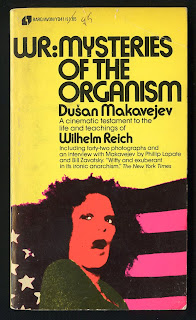What a weird little movie. Roger Ebert noted when he chose to include a review of this film in his “Great Movies” series, that he expected there to be some backlash. Whether said backlash occurred I don’t know, but watching the film it’s clear to see why he was so speculative. Dusan Makavejev’s W.R.: Mysteries of the Organism (1971) is without a doubt one of the oddest film’s I’ve encountered; a semi-spoof documentary on experimental psychologist Wilhelm Reich (the W.R. of the title) combined with a fictional narrative concerning Yugoslavian sexual liberation. Yes, you read that right.
Reich was a European scientist on the run from Hitler for his pro-communist ideals. After claiming to have discovered a molecule called the “orgone”, a unit of sexual pleasure, he sought asylum in the U.S. when Stalin suspected him of anti-communist behavior. Somewhere in between switching political ideologies, Reich developed the Accumulator, a wooden box lined with metallic plating that he claimed stimulated orgone movement in beings who sat inside it. Not surprisingly, the psychologist, whose practices encouraged people to moan and gyrate in large group gatherings, was dismissed as a quack. His activities attracted the eyes of HUAC and he was jailed for the remainder of his life as the U.S. government burned almost the entirety of his published works.
These segments comprise the first third of W.R. before giving way to footage of Tuli Kupferberg, the lead singer of the New York rock group The Fugs, dressing in paramilitary gear and carrying a faux M16 to march in front of NYC landmarks while the band’s song “Kill for Peace” mocks U.S. action in Vietnam. Kupferberg’s actions draw attention from police, who aren’t quite sure what to do with him, especially after he begins to simulate masturbation with the barrel of the riffle. There’s also some footage of transsexual icon Jackie Curtis, explaining her sexual inadequacies as a male, thrown in for good measure.
The documentary elements of the film fade for a time, giving way to a Serbo-Croatian farce about two young women attempting to find sexual and political freedom. They both see a connection between sex and politics, but each is primarily interested in a different end of the spectrum; sexual liberation through politics and political liberation through sex. They team up despite their differing goals, convinced they can find their own brand of communism and their own type of orgasm by seducing a Russian-born figure skater, a genuine soviet. This all goes horribly wrong for the more politically-minded of the revolutionaries when, after the sex, the skater becomes aggressive and violent. In a late scene, the woman’s undaunted talking head, severed by an ice skate, continues with her political rhetoric.
What does this all mean? I have no idea. Makavejev claimed that his film was the actualization and execution of the montage theories of Eisenstein, and that the Russian master failed to use them to their humorous potential. He was certainly an iconoclastic director, and if you view W.R. as his commentary on the absolute chaos of the political upheaval of the late 1960s it makes sense that it could make sense…if that means anything. It seemed to make sense to the administration of Harvard, who hired Makavejev on as a professor.
W.R. closes after a psychedelic “star wipe” obscures a procedure of plaster casting, a countercultural trend of the day. The graphic was added to a version released by the BBCs Channel 4 that Makavejev altered himself. While, this scene is probably the most graphic in the film without the edit, it’s better with the change, simply because it makes the sequence, and thus the film, even weirder.
Language: English/Serbo-Croatian
Runtime: 84 Minutes
Available @ vimeo.com
Grade: 2 Hats Off


0 comments:
Post a Comment